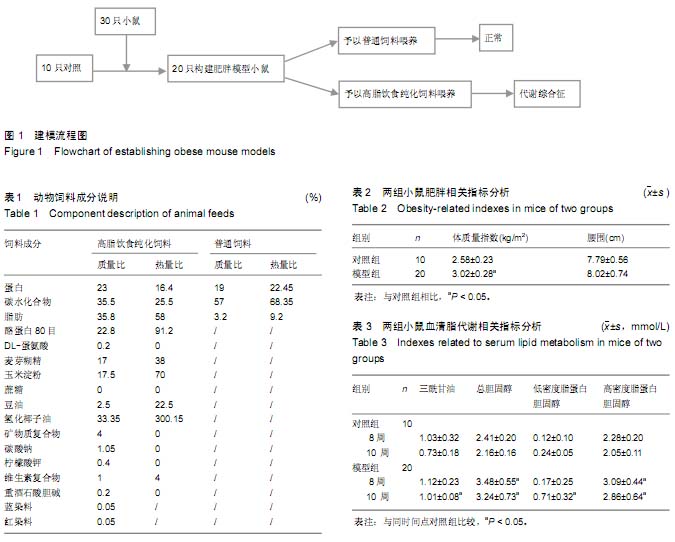| [1] 郭妍,迟晓丽,马渊,等.喂养型代谢综合征小鼠及大鼠模型的建立方法探讨[J].中国药理学通报,2010,26(4):551-556.
[2] 崔明霞,李瑞莲,李文广,等.小鼠代谢综合征模型的特征及西布曲明的治疗作用研究[J].中国药理学通报,2009,25(5):621-625.
[3] 郭妍,迟晓丽,马渊,等.六味地黄汤活性成分组方LW-AFC对高热量饲料诱导小鼠代谢综合征的改善作用[J].中国药理学与毒理学杂志,2013,27(3):367-373.
[4] 陈伟,王莉莉,刘洪英,等.过氧化物酶体增殖物激活受体β亚型激动剂GW501516对胰岛素抵抗模型小鼠的胰岛素增敏作用[J].中国药理学与毒理学杂志,2008,22(2):88-94.
[5] 李国梁,郭俊杰,孙希美,等.氟伐他汀缓释片对代谢综合征小鼠血清hs-CRP、IL-1β、IL-4水平的影响[J].山东医药,2013,53(8): 30-32.
[6] 朱男,韩雅玲,闫承慧,等.血管紧张素(1-7)在高盐高脂饮食诱导的代谢综合征小鼠肾脏损伤中的作用[J].解放军医学杂志, 2013, 39(10):787-791.
[7] 杨晓娣,卫旭宇,蒋森,等.高脂饮食诱导的裸鼠代谢综合征模型中结肠癌移植瘤生长和瘤内微血管形成的实验研究[J].中华消化杂志,2013,33(6):403-408.
[8] 朱冰坡,范利,曹剑,等.代谢综合征/心肌梗死大鼠模型的建立[J].中国组织工程研究,2012,16(2):265-268.
[9] Breyer MD, Bottinger E, Brosius FC, et al. Mouse Models of diabetic nephropothy. J Am Soc Nephml. 2005;16:27-45.
[10] 庞广昌,陈庆森,胡志和,等.过度营养与人体代谢和疾病关系的研究进展[J].食品科学,2013,34(15):373-396.
[11] 黄江荣,杜亚明,鄢进,等.加味苓桂术甘汤对代谢综合征大鼠血清抵抗素、脂联素、胰岛素、胰岛素抵抗的影响[J].中国实验方剂学杂志,2013,19(6):227-230.
[12] 李莉,张锦,彭阳,等.代谢综合征小鼠肝脏改变及肝脏清道夫受体B1的表达[J].中国老年学杂志,2004,24(12):1168-1171.
[13] 沈纪中.五甲基槲皮素对谷氨酸钠诱导的代谢综合征小鼠的作用研究[D].武汉:华中科技大学,2009.
[14] 丛维娜.代谢综合征合并非酒精性脂肪肝炎小鼠模型的建立及银杏叶提取物治疗代谢综合征作用及其机制的探讨[D].北京:中国协和医科大学,2008.
[15] 王丽,张晓琳,李莫涵,等.红景天、蛹虫草、大黄配伍治疗代谢综合征的实验研究Ⅴ-调节糖代谢紊乱作用机制研究[J].中国中药杂志,2013,38(12):1972-1976.
[16] 胡健萍.代谢综合征小鼠模型的建立及中药复方干预[D].北京:北京协和医学院,2009.
[17] 田金英,陈玲,张晓琳,等.红景天、蛹虫草、大黄配伍治疗代谢综合征的实验研究Ⅱ-治疗肥胖症作用[J].中国中药杂志,2013, 38(9):1411-1415.
[18] 孟春燕,蔡翔宇,白婷,等.白藜芦醇对小鼠营养性肥胖伴生殖功能损害的作用[J].国际内分泌代谢杂志,2013,33(3):155-157, 162.
[19] 杨蔚芹.三甲基芹菜素对谷氨酸钠合并哺乳期营养过剩诱导的代谢综合征小鼠的作用研究[D].武汉:华中科技大学,2010.
[20] 张苏丽.AT1受体自身抗体阳性大鼠的后代在成年期对代谢综合征易感性增加及机制探讨[D].山西:山西医科大学,2012.
[21] 李娟,陈玲,张晓琳,等.红景天、蛹虫草、大黄配伍治疗代谢综合征的实验研究Ⅰ-改善胰岛素抵抗作用[J].中国中药杂志,2012,37(11):1614-1619.
[22] 周云枫,李沙,苏文,等.不同脂肪含量的高脂纯化配方饲料对大、小鼠代谢综合征发生的影响[J].基础医学与临床,2012,32(3): 273-277.
[23] 李睿,饶国涛,何荣华,等.柚皮苷对代谢综合征的改善及其机制研究[J].临床心血管病杂志,2011,27(10):779-783.
[24] 陈玉涵,李荣娜,王红霞,等.硫化氢对代谢综合征小鼠血糖和血胰岛素水平的调节[J].中国医药导报,2013,10(35):11-13, 34.
[25] 陈玉涵,曾翔俊,李荣娜,等.硫化氢对代谢综合症小鼠心脏的保护作用[J].中国分子心脏病学杂志,2009,9(5):266-271.
[26] 张泽生,张楠,冯帆,等.果葡糖浆诱导实验性代谢综合征大鼠模型[J].食品研究与开发,2014,35(18):20-23.
[27] 梅妍,王建平,李兰青,等.食物诱导型代谢综合征家兔模型的建立和评价[J].天津医药,2014,(10):984-987.
[28] 程霄瀚,刘莉,隋艳波,等.喂养型代谢综合征大鼠模型成模率分析[J].山东医药,2013,53(37):15-17.
[29] 刘福成.应变及应变率分析对代谢综合征大鼠心脏收缩功能的评估及相关研究[D].广州:南方医科大学,2011.
[30] 陈冯梅,陆宏虹,郭志荣,等.老年代谢综合征、非代谢综合征人群血尿酸水平与2型糖尿病的相关性[J].中国老年学杂志,2013, 33(24):6082-6084.
[31] 费扬帆,王椿,刘关键,等.不同代谢综合征诊断标准运用于四川地区人群的比较分析[J].四川大学学报(医学版),2012,43(4): 547-552.
[32] 胡浙芳,章荣华,黄李春,等.四种代谢综合征诊断标准在浙江省城市人群中应用情况的比较[J].中华预防医学杂志,2014,48(6): 507-511.
[33] 沈纪中.高糖饮水诱导代谢综合征小鼠模型的实验研究[J].中国临床药理学与治疗学,2014,19(9):1011-1015.
[34] 陈迪芳,林金秀.代谢综合征患者人软骨糖蛋白-3浓度变化及与危险因素个数的关系[J].中国循环杂志,2014,29(3):201-205.
[35] 高扬,吕滨,侯志辉,等.冠心病合并代谢综合征患者冠状动脉粥样硬化的特性[J].中华心血管病杂志,2013,41(11):935-939.
[36] 胡健萍,闫熙,杨志伟,等.饮食诱导代谢综合征小鼠模型的建立[J].中国比较医学杂志,2009,19(6):34-38.
[37] 王敏,王磊,任续功,等.雌激素减少与代谢综合征关系的实验研究[J].山东大学学报(医学版),2006,44(5):492-495, 500.
[38] 唐新征,张炜宁,张会霞,等.益肾疏肝汤对MS小鼠糖脂代谢影响的实验研究[J].中国医药导报,2010,07(19):23-25, 28.
[39] 平立风.不同剂量剂型氟伐他汀对代谢综合征小鼠胰岛素抵抗及超敏C反应蛋白的影响[D]. 青岛:青岛大学,2012.
[40] 刘聪,吴波,李莉,等.代谢综合征小鼠肝脏过氧化物增殖体受体γ共同作用因子-1的表达[J].世界华人消化杂志,2007,15(18): 1989-1994. |
